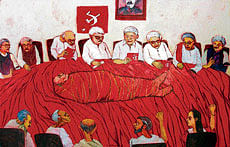Changing squalid Kolkata a challenge for Mamata

In every squalid street and in every despairing neighbourhood, billboards beckon the people to exercise their franchise for it is their future. The graffiti on shabby walls of shabbier buildings proclaim Mamata Banerjee's promise: “we do not seek revenge, we want change.”
In this sprawling urban malignity, countless festoons bearing Banerjee's twin bright green-and-saffron flower symbol hang from lampposts, doorways and overhead power cables. There are posters of the bright red and hammer and sickle too. It is election season, but unlike other election seasons in the past, this time the Trinamool Congress is preparing for victory.
The electoral battle is now being fought out in the impoverished districts of West Bengal, a state that remains desperately poor by any standard, but the clock is ticking for Kolkata which will go to the polls on May 7 on the grand promise by Banerjee to turn it into a city as modern as London with a Delhi Gate-like Kolkata Gate on the eastern fringes next to one of the world's biggest open garbage dumps.
Banerjee has made other sundry promises: change the colour red of the massive colonial-era Writer's Building, the state secretariat, and of Lal Bazar, the city police headquarters. "I am not sure whether she will go ahead with that promise," Calcutta University retired English professor Sunando Sanyal said, laughing aloud at the thought of having to see the seat of power in the state take on a different hue.
Once the intellectual and economic capital of India, Kolkata - Calcutta, as it was known till a few years back - suffered a gradual decline, much of it as a consequence of the Left Front government's 34 years of uninterrupted governance marked by frequent strikes, water logging, power cuts, traffic snarls. The CPM-led Left Front government presided over the decline of not just the state, but also Kolkata.
Institutions like the police, civil administration, schools, universities, even hospitals were politicised. State government employees were encouraged to be part of a Orwellian Coordination Committee which held Writer's Building to ransom, bringing in its wake a culture of indolence and willful shunning of work. The result, Left Front critics say, was a sapping of administrative vitality and a complete lack of work culture.
"The singular contribution of the Left Front was the near-total erosion of work culture, a phenomenon which seeped into every working individual working either in the public or private sector," said Dipak Ghosh, a former secretary to the government of West Bengal, who after retirement, won two Assembly elections as a Trinamool nominee. The Communists, however, remained immune to deteriorating situation of Kolkata. Over the past few years, a couple of flyovers and malls have come up which the CPM projects as markers of development. "What use are unplanned flyovers when higher education is in the doldrums," asked Shuvaprasanna Bhattacharya, an acclaimed painter who has thrown in his lot with Mamata.
"Depsite the hardships of Partition, Bengal's glorious past, post-independence, was continued by then chief minister Bidhan Chandra Roy. Then followed the rule of another luminary Prafulla Sen. How can one compare these greats with the likes of Jyoti Basu who heralded the decline of Kolkata and the state?" an angry Bhattacharya, whose recent work (see picture) created a furore in the city's charged political circles, said.
The “determined clique of Marxists” and the Left political machinery, according to Ghosh, destroyed the education system, the healthcare infrastructure (people still get afflicted by and die of viral hepatitis, diphtheria, Japanese encephalitis and meningococcal meningitis in Kolkata) and public finances.
There is no doubt that a 'Mamata wave' is sweeping over Kolkata and for many she is the hope for mitigating the decay and squalour that pervade not just slum neighbourhoods but middle-class residential areas in the south. But given her temperamental attitude and inconsistency in fulfilling promises, questions are being raised over her capacity to govern, sitting at Writer's Building.
Last year, her party captured the Kolkata Municipal Corporation, but governing a chaotic and dysfunctional state would be quite another story. “Till a few years ago, the middle class sniggered at her ways, her shrill, high-pitched battle cries against the Marxists was equated with loud-mouthed and quarrelsome domestic helps. That seems to be changing now among the snobbish Bengalis,” a Trinamool functionary said.
Deccan Herald is on WhatsApp Channels| Join now for Breaking News & Editor's Picks